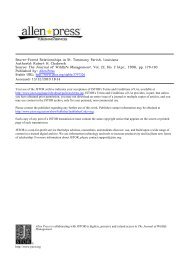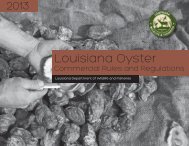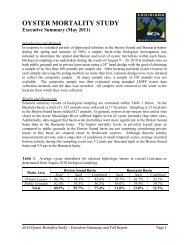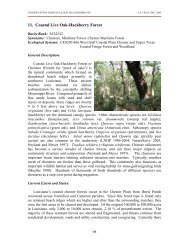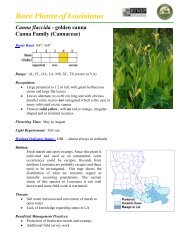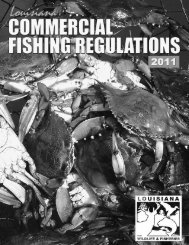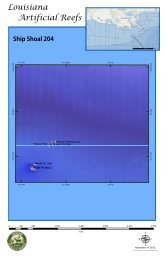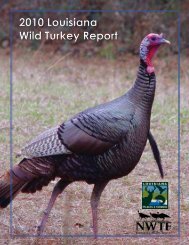Distribution and Relative Abundance of Blue Catfish,lctalurus
Distribution and Relative Abundance of Blue Catfish,lctalurus
Distribution and Relative Abundance of Blue Catfish,lctalurus
Create successful ePaper yourself
Turn your PDF publications into a flip-book with our unique Google optimized e-Paper software.
DISTRIBUTION AND RELA11VE ABUNDANCE OFBLUE CATFJJSH, <strong>lctalurus</strong> furcatus, AND CHANNELCATFlSH, <strong>lctalurus</strong> punctatus, WIm RELATIONTO SALINITYW. GUTHRIE PERRY, JR.'Louisiana Wild Life <strong>and</strong> Fisheries CommissionGr<strong>and</strong> Chenier, LouisianaABSTRACTA study was conducted with blue <strong>and</strong> channel catfish to determinethe effect <strong>of</strong> salinity upon distribution in a tidal bayou complex onRockefeller Refuge, Gr<strong>and</strong> Chenier, Louisiana.Stations were spaced at locations from the Gulf <strong>of</strong> Mexico to Gr<strong>and</strong>Lake, a large freshwater body <strong>of</strong> water which is apparently quiteproductive <strong>of</strong> blue <strong>and</strong> channel catfish. Collections were made primarilywith an otter trawl towed for 10-minute intervals at each samplingstation. Hoop nets, wire traps, trammel nets, trot lines <strong>and</strong> rotenonewere used to verify trawling results.<strong>Distribution</strong>al data indicated that a 2:1 ratio existed between blue<strong>and</strong> channel catfish <strong>and</strong> that they are more abundant in waters withaverage salinities <strong>of</strong> 3.7 <strong>and</strong> 1.7 ppt, respectively. However, bothspecies were collected from waters with salinities ranging up to 11.4 ppt.INTRODUCTIONThe increase in fish farming in hatcheries <strong>and</strong> impoundments inLouisiana indicates that channel catfish, Ictalurus punctatus, <strong>and</strong> bluecatfish, I. furcatu8, are desirable species to grow as food fish. Commercialfishing alone cannot satisfy the rising dem<strong>and</strong> for caJtfish asfood.Several states including Arkansas, Alabama, Texas, Georgia, Florida,Oklahoma, Kansas, Missouri, Mississippi, California <strong>and</strong> Louisiana areconducting management research with catfish. Thous<strong>and</strong>s <strong>of</strong> pageshave been written pursuant to feeding requirements, reproductive needs,parasites, transport <strong>and</strong> harvest <strong>of</strong> blue <strong>and</strong> channel catfish. However,only a few papers have been prepared involving the ecology <strong>of</strong> thespecies <strong>and</strong> among these are only limited accounts <strong>of</strong> Ictalurid collectionsin brackish water.Mather (1881) reported that animals with s<strong>of</strong>t skins are easilyaffected when changed from fresh to salt water. Frogs die soon, <strong>and</strong>as they breathe by means <strong>of</strong> lungs, it follows that it is entirely fromosmosis, or absorption by the skin. He states that probably catfish(lctaluridae) would not st<strong>and</strong> the change as well although there aretwo marine species (Galeichthys felis <strong>and</strong> Bagre marinus) on the coast.Gunter (1945) took blue catfish in extremely limited numbers fromTexas bays. He recorded one specimen taken in water containing 6.3 pptsalinity. <strong>Blue</strong> catfish were collected by Rounsefell (1964) in waterswith salinities <strong>of</strong> 6.5 ppt.In a taxonomic survey <strong>of</strong> the fishes <strong>of</strong> the Delta National WildlifeRefuge, Kelly (lg65) collected 193 specimens from estuarine waters.He concluded that salinIty appeared to be a limiting factor on distributionwhen a concentration <strong>of</strong> 2.0 ppt was reached. Kelly <strong>and</strong> Carver(1965) reported that all specimens <strong>of</strong> blue catfish collected for an age<strong>and</strong> growth study were taken from waters having salinities less than7.0 ppt; most individuals were taken in waters having salini,ties <strong>of</strong>0.8 to 2.0 ppt.1 This paper Is based In part on a thesis presented for partial fulfillment <strong>of</strong> requirementsfor the degree <strong>of</strong> Master <strong>of</strong> Science while Graduate Assistant, Louisiana CooperativeFishery Unit, Louisiana State University, Baton Rouge. Louisiana.436
Bayless <strong>and</strong> Smith (1962) reported the absence <strong>of</strong> channel catfishin the brackish waters <strong>of</strong> the Neuse River. Kelly (1965) stated thatthe occurrence <strong>of</strong> the species on the Delta Refuge was rare. His dataindicates that only one specimen 13.0 inches total length was capturedin 1.03 ppt salinity.Fish culture in coastal impoundments <strong>of</strong> Louisiana is fast gainingin importance. This project was conducted as a pilot experiment forfuture studies in brackish water pond culture which are presentlyunder way at Rockefeller Wildlife Refuge <strong>of</strong> the Louisiana Wild Life<strong>and</strong> Fisheries Commission, Gr<strong>and</strong> Chenier, Louisiana.DESCRIPTION OF STUDY AREASampling stations were established March, 1965, in a tidal bayouon Rockefeller Wildlife Refuge, Gr<strong>and</strong> Chenier, Louisiana.Rockefeller Wildlife Refuge comprises 85,000 acres <strong>of</strong> marshl<strong>and</strong>located in the southeast corner <strong>of</strong> Cameron Parish <strong>and</strong> southwest corner<strong>of</strong> Vermilion Parish (Figure 1). The refuge is situated between 26.5miles <strong>of</strong> Gulf shoreline <strong>and</strong> the Gr<strong>and</strong> Chenier-Pecan Isl<strong>and</strong> beachridge complex.The Rockefeller marsh, resulting from an ancient change in thecourse <strong>of</strong> the Mississippi River, has an average elevation <strong>of</strong> 1.1 feetabove sea level. Tidewater enters the refuge through five separatechannels. The average tidal fluctuation is approximately one foot.Cameron Parish has an average annual precipitation <strong>of</strong> 52.91 inches.The statewide average is 55.45 inches. July <strong>and</strong> September are themonths <strong>of</strong> maximum rainfall with approximately eight <strong>and</strong> seveninches, respectively. The minimum months are November <strong>and</strong> Januarywhich average two <strong>and</strong> one-half inches. Cameron Parish has a meantemperature <strong>of</strong> 68.2 degrees, compared to the state average <strong>of</strong> 67.4degrees. The warmest month is July, <strong>and</strong> January is the coldest(Nichols, 1959).MATERIALS AND METHODSThe sample stations were established in a tidal bayou from the Gulf<strong>of</strong> Mexico to Gr<strong>and</strong> Lake, a large freshwater lake. This complex ismade up <strong>of</strong> both natural bayous <strong>and</strong> artificially constructed canals.The study canals were approximately 50 feet wide <strong>and</strong> 23.5 mileslong. Water in the study areas was brackish with salinities rangingfrom 0.18 ppt to 35.9 ppt. The depth varied from seven to 12 feet.Turbid waters were frequently present in the area. Secchi diskreadings ranged from two to 13 inches. The canal bottoms were highin organic matter <strong>and</strong> free <strong>of</strong> rooted vegetation.Research for this study was initiated with the establishment <strong>of</strong> ninesampling stations (Figure 2) on March 11, 1965, <strong>and</strong> terminatedFebruary 26, 1966. Sample stations were placed in areas that possessedrelatively low, medium, <strong>and</strong> high salinity ranges. Station 1 waslocated at the entrance <strong>of</strong> Joseph Harbor Bayou into the Gulf <strong>of</strong> Mexico.This station had the highest individual salinity reading, 35.9 ppt, <strong>and</strong>an average <strong>of</strong> 23.1 ppt. The location <strong>of</strong> Station 2 was 1.8 miles fromthe Gulf near the entrance <strong>of</strong> Humble Canal into Joseph Harbor Bayouwith an average salinity <strong>of</strong> 23.3 ppt. Station 3 is located 3.6 milesfrom the Gulf on the Humble Canal. This station was placed at thejunction <strong>of</strong> Deep Lake Canal <strong>and</strong> had an average salinity <strong>of</strong> 16.5 ppt.This was the station nearest the Gulf <strong>of</strong> Mexico at which freshwatercatfish were collected. The intersection <strong>of</strong> Headquarters Canal <strong>and</strong>Humble Canal marked Station 4, 6.2 miles from the Gulf. The salinityaverage was 13.6 ppt. Station 5, 7.1 miles from the Gulf, was locatedon the upstream side <strong>of</strong> the East End Locks in the Property Line Canal.The purpose <strong>of</strong> the structure was to prevent salt water intrusion inthe fresh marsh <strong>and</strong> to provide drainage <strong>and</strong> consequently was closedmost <strong>of</strong> the summer <strong>and</strong> early fall. The average salinity for Station 5was 5.2 ppt. Station 6, with an average salinity <strong>of</strong> 6.0 ppt, was 10.5miles from the Gulf. The last station on the refuge, Station 7, waslocated three miles from Station 6 <strong>and</strong> had an average salinity <strong>of</strong>437
11 11 lrlr- I •• , I,"11 lr~ < ... UJ • Ilr-S~ :......11I •rs. ~ :0•11- trlI-
~II!I 11f''I 0 I ?SCale In MiloLEGENO-c::.: Road,1':;:1$1CanalR..tryoir orta.JFigure 2.Location <strong>of</strong> sampling stations. Rockefeller Refuge.8.7 Pllt. Station 8 was placed at the junction <strong>of</strong> Pan Am <strong>and</strong> SuperiorCanals. The average salinity was 3.5 ppt. The last sampling station,Station 9, was at the entrance <strong>of</strong> Superior Canal into Gr<strong>and</strong> Lake,app;roximately 28.5 miles from the Gulf. This station had an averagesaliil-ity <strong>of</strong> 1.7 ppt.From March to August, 1965, a Solu Bridge Model RB2-3341conductivity <strong>and</strong> temperature meter was used to determine salinity.439
For the remainder <strong>of</strong> the study salinity determinations were madeby the Mohr Method (American Public Health Association, 1960).Gear used to capture catfish included hoop nets, wire traps, trammelnets, trot lines, rotenone <strong>and</strong> otter trawl. A 16-foot, one-half-inch barmesh otter trawl towed with SO-foot manila rop€s from 10 minutes ateach station (approximately one-fourth mile) demonstrated least selectivityamong gears used. Sampling was conducted monthly at establishedstations. The nylon trammel nets used had 10-inch (bar measure) meshouter walls <strong>and</strong> a one-inch (bar measure) inner wall. The nets were fourfeet deep <strong>and</strong> 50 feet in length. One-inch mesh hoop nets with 18-inchwooden hoops <strong>and</strong> wire traps constructed <strong>of</strong> one-inch mesh galvanizedwire, were fished along the sampling complex. Rotenone at a concentration<strong>of</strong> 1 ppm was applied to verify netting results.Species taken were identified by characters described by Eddy (1957),Moore (1957) <strong>and</strong> the author. Separating feaJtures used were:1. <strong>Blue</strong> <strong>Catfish</strong> - Anal fin with 30 or more rays-Maxillary barbel short, not reaching to gill opening- eye in anterior part <strong>of</strong> head- three lobed air bladder; appears as two2. Channel catfish - Anal fin with 20-29 rays- maxillary barbel long,openingreaching beyond gill- eye in center <strong>of</strong> head- air bladder two lobed; appears as oneRESULTS AND DISCUSSIONPhysiological <strong>and</strong> toxic effects <strong>of</strong> saline water on freshwater fishhave been studied by many workers. Lethal effects may be the result<strong>of</strong> osmotic pressure rather than the specific toxicity <strong>of</strong> individual components<strong>of</strong> the solution.The abundance <strong>of</strong> blue catfish in areas north <strong>of</strong> Station 7 indicatethat this species is more abundant in waters with average salinities <strong>of</strong>3.7 ppt <strong>and</strong> lower (Tables I <strong>and</strong> II). However, one <strong>of</strong> the 689 bluecatfish (305 grams) collected during this study was in an area with asalinity <strong>of</strong> 11.4 ppt.Salinity seemed to be the limiting factor on channel catfish in waterswith monthly salinities ranging above 1.7 ppt. Of the 338 channel catfishcollected, four were obtained from a rotenone sample in an area witha salinity <strong>of</strong> 11.4 ppt. The sizes ranged from 125 grams to 1.4 pounds.Both species were observed ranging further downstream in January<strong>and</strong> February. The salinities at the point <strong>of</strong> collection had droppeddrastically (22.4 ppt December to 1.6 ppt February) as a result <strong>of</strong>heavy rains. Thus, it seems that the catfish were following the freshwateras the salt wa;f;er was pushed back.Rotenone samples <strong>of</strong> an impoundment taken in June revealed bothblue <strong>and</strong> channel catfish present. Most <strong>of</strong> the nine channel catfishcollected were heavy with eggs. The weights <strong>of</strong> the catfish ranged from0.8 to 10.0 pounds. Two blue catfish were collected which weighed25.5 pounds <strong>and</strong> 70 grams. The 25.5-pound fish was a male. This80-acre impoundment <strong>of</strong>ten has salinities ranging in excess <strong>of</strong> 6 ppt.However, the salinity was 4.3 ppt when the fore mentioned sample wastaken.The linear regression calculated for numbers <strong>of</strong> channel <strong>and</strong> bluecatfish <strong>and</strong> the salinity at which they were taken from 10-minute trawlsamples is represented in Figure 3.440
TABLE 1-MONTHLY SALINITIES (PPT.) OCCURRING AT NINESAMPLING STATIONS IN JOSEPH HARBOR BAYOUGRAND LAKE TIDAL BAYOU COMPLEX, ROCKE·FELLER REFUGE, 1965 TO 1966.Month I II III IV V VI VII VIII IXAverage 23.1 23.3 16.5 13.6 5.2 6.0 3.7 3.5 1.7II>lI>I-'May 4.3 4.6 5.2 5.0 4.9 7.1 3.3 4.4 0.8June 19.0 18.8 16.0 17.2 6.8 6.9 6.0 5.7 4.4July 29.8 29.1 21.3 17.2 6.7 8.4 3.2 2.4 2.0August 22.8 26.2 17.4 19·9 2.2 2.7 0.9 0.7 1.8September 16.4 19.6 22.2 11.0 5.9 5.7 3.0 3.1 1.3October 28.3 30·9 26.0 26.3 6.8 6.4 4.3 5.1 1.6November 29.4 28.9 21.8 22.1 9.4 11.0 6.5 5.2 1.2Dece;nber 27.3 22.5 26.1 14.3 7.0 7.8 7.5 5.0 1.2January 35.9 35.5 3.8 1.7 1.3 1.4 0·9 1.4 1.7February 17.6 16.7 5.0 1.3 1.4 2.2 1.0 1.6 1.2
TABLE 2-PERCENTAGE OF BLUE AND CHANNEL CATFISHCOLLECTED AT EACH SAMPLING STATION INJOSEPH HARBOR BAYOU-GRAND LAKE TIDALBAYOU COMPLEX, ROCKEFELLER REFUGE, 1965 TO1966.I II III IV V VI VII VIII IXAverage 23.1 23.3 16.5 13.6 5.2 6.0 3.7 3.5 1.7Species stations~lcita1urus:1'urcatus 0.0 0.4 6.0 11.7 5.4 10.0 20.1 19.6 26.8Icta1uruspunctatus 0.0 0.0 0.0 0.0 5.1 2.6 17.8 28.2 46.3Month1ysa1inity ppt. (see Table I)Low 4.3 4.6 3.8 1.3 1.3 1.4 0.9 0.7 0.8High 35.9 35.5 26.1 26.3 9.4 1LO -7.5 5.7 4.4
403020- - Y' 1.21 + (-,12}(x)_.- Y' 6.22 I (-.34)(x)...r:;;:·10,..............'0"~ 0"-OJ.DE::lz-10.-.~~'-, ·-..£!!2'!ne, eo"., _.-..!!.~........... ----.--., -'-81 11....ĊO;:. .....r'.,,__ , , ,' ......."-20-30-40~±----r:---..---""T--.....,--.....----r--.....---.....o ~ m 30 ~ ~ ~ ro ~S!llinily (ppl.)Figure 3.<strong>Distribution</strong> <strong>of</strong>;channel <strong>and</strong> blue catfish with salinity.SUMMARYRockefeller Wildlife Refuge is an humid, temperate area characterizedby waters <strong>of</strong> moderate salinity <strong>and</strong> very high turbidity, althoughconsiderable variations in these factors were frequent.Data collected from monthly samples indicate that blue catfish weremore abundant in waters with salinities <strong>of</strong> 3.7 ppt <strong>and</strong> below. Channelcatfish were more abundant in habitats having sea-water concentrationsless than 1.7 ppt. However, a 2:1 ratio existed between blue <strong>and</strong>channel catfish <strong>and</strong> they were found in waters with salinities ranging upto 11.4 ppt.443
This study, like most others, involves the observation <strong>of</strong> one stage <strong>of</strong>the life cycle. There is a definite need for further studies on theeffect <strong>of</strong> salinity upon the commercially important catfish. Laboratorybioassey methods should be used along with field observations to determineeffects on eggs, fry, fingerlings, <strong>and</strong> adult catfish.LITERATURE CITEDAmerican Public Health Association. 1960. St<strong>and</strong>ard methods for examination<strong>of</strong> water <strong>and</strong> waste water, including sediments <strong>and</strong> sludges.11th ed. American Public Health Association, Inc., New York. 626 p.Bayless, J. D. <strong>and</strong> W. B. Smith. 1962. Survey <strong>and</strong> classification <strong>of</strong> theNeusa River <strong>and</strong> tributaries, North Carolina. North Carolina WildlifeResources Commission, Job 1-A, Project F-14-R, final report.33 p.Eddy, S. 1957. How to know the freshwater fishes. William C. BrownCompany, Dubuque, Iowa. 253 p.Gunter, G. 1945. Studies <strong>of</strong> marine fishes <strong>of</strong> Texas. Institute MarineScience, University <strong>of</strong> Texas 1(1) :1-190.Kelley, J. R, Jr. 1965. A taxonomic survey <strong>of</strong> the fishes <strong>of</strong> DeltaNational Wildlife Refuge with emphasis upon distribution <strong>and</strong>abundance. M. S. Thesis, Louisiana State University Library,Baton Rouge. 133 p.Kelley, J. R. <strong>and</strong> D. C. Carver. 1965. Age <strong>and</strong> growth <strong>of</strong> blue catfish,Ictalurus faJrcatus (LeSueur), in the recent delta <strong>of</strong> the MississippiRiver. Proceedings 19th Annual Conference Southeastern AssociationGame <strong>and</strong> Fish Commissioners. 19:296-299.Mather, F. 1881. Fishes which can live in both salt <strong>and</strong> fresh water.Transactions American Fisheries Society. 10 :65-75.Moore, G. A. 1957. Fishes. p. 33-210. Invertebrates <strong>of</strong> the UnitedStates. McGraw-Hill Book Company, Inc., New York. 819 p.Nichols, G. 1959. Geology <strong>of</strong> Rockefeller Wildlife Refuge <strong>and</strong> GamePreserve, Cameron <strong>and</strong> Vermilion Parishes, Louisiana. TechnicalBulletin <strong>of</strong> the Louisiana Wild Life <strong>and</strong> Fisheries Commission. 5-35.Rounsefell, G. A. 1964. Reconstruction study <strong>of</strong> the fisheries <strong>of</strong> theestuarine areas traversed by the Mississippi River. Gulf OutletProject. United States Fish <strong>and</strong> Wildlife Service, Fishery Bulletin,63 (2) :373-393.ACKNOWLEDGMENTI wish to express my personal thanks to Dr. R. O. Smitherman,Auburn University, for his many helpful suggestions <strong>and</strong> guidance informulating this study.Thanks are given to Dr. J. W. Avault, Assistant Pr<strong>of</strong>essor <strong>of</strong>Forestry <strong>and</strong> Wildlife Management, Louisiana State University; Mr.Ted J oanen <strong>and</strong> Mr. Robert Chabreck, refuge biologists, RockefellerWildlife Refuge <strong>of</strong> the Louisiana Wild Life <strong>and</strong> Fisheries Commissionfor their constructive criticism <strong>and</strong> comments <strong>of</strong> this manuscript.444



